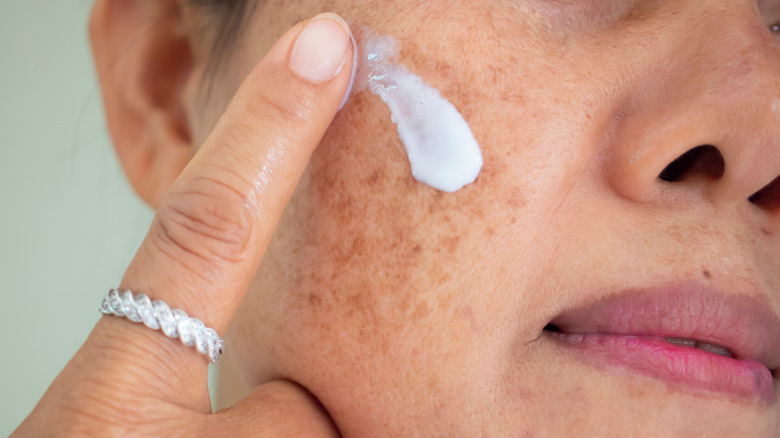Melasma: The Most Common Causes
If you were like many other teens, you spent your adolescence battling acne spots on the journey to clear skin. Now that you're older, you may have finally tamed your pimples and pustules, only to find a new blemish taking up real estate on your face: melasma. Melasma is a skin condition that causes dark spots and patches, often on the cheeks, above the mouth, on the chin, and around the forehead (per Medical News Today). According to the American Academy of Dermatology Association, it often appears in adulthood, mostly in women with medium to dark skin tones.
Melasma is harmless and doesn't cause any pain, though it might make some people feel self-conscious. Brown patches can sometimes be successfully faded using clinical treatments, as well as lifestyle tweaks like changing up your diet. However, they may return, especially if you're exposed to melasma triggers. Here are some of the most common causes of the condition and things to avoid to keep melasma pigmentation under control.
Hormonal changes
One reason women are more likely to get melasma than men— a whopping 90% of people with the skin disorder are women, notes Cleveland Clinic — boils down to hormone fluctuations, particularly during pregnancy. "Hormones are active during pregnancy and it can be a trigger for melasma," Dr. Corey L. Hartman, a dermatologist, told Byrdie. That's why melasma is often known as the "mask of pregnancy." "However, [pregnancy] is not the only trigger. Menopause, oral contraceptives, and even normal monthly hormone fluctuations can cause melasma to worsen," Hartman added.
Other hormonal changes and disruptions can also trigger dark patches. For example, some types of hormone therapy, especially treatments containing estrogen and progesterone, are known to set off melasma. Thyroid diseases such as hypothyroidism are also associated with melasma.
Treating hormonal imbalances may improve melasma symptoms, along with steering clear of hormonal medications when possible. As for pregnancy-induced melasma, patches will likely stick around for at least a few months before gradually fading after delivery (per Healthline).
Light exposure
You already know sun damage can completely wreck your skin. Besides age spots, wrinkles, and skin cancer, sun exposure can also worsen melasma pigmentation. The American Academy of Dermatology Association explains that sunlight encourages melanin production, which for melasma sufferers means more darkened patches of skin. This is especially true if you already have another risk factor for melasma. Dr. Shadi Kourosh, director of the Pigmentary Disorder and Multi-Ethnic Skin Clinic at Massachusetts General Hospital, shared with Harvard Health Publishing: "Underlying factors such as hormonal changes may not manifest until a person goes on vacation to a southern location like Florida, or during the summertime when she spends more time in the sun. [...] The sun is the major exacerbating factor, whatever the underlying cause."
Slathering on sunblock throughout the day is one way to prevent melasma flare-ups. However, don't overlook other types of light exposure. Cleveland Clinic warns that tanning beds and LED lights can trigger skin discoloration. Even screen time can be a culprit. "Blue light emitted from your smart device or laptop has been shown to increase pigmentation on the face, making melasma worse," Dr. Orit Markowitz, an associate professor of dermatology, told Well+Good.
Heat exposure
Along with basking in the sun, spending time in the heat — whether that be on a blistering summer day or, say, in a steamy bathroom — can also aggravate melasma. That could explain why many people started noticing melasma patches cropping up on their faces at the height of the COVID-19 pandemic when mask-wearing was the norm. Dermatologist Dr. Jessica Weiser revealed to Well+Good, "Wearing a mask traps accumulated heat against the skin surface, and that can further augment the temperature-induced component of melasma." She noted that people with melasma should avoid heat when possible and cool their skin quickly after being exposed to high temperatures.
Consider sources of heat in your daily routine, from blow dryers to a hot stove in your kitchen. Though heat can't be avoided entirely, you can minimize contact, such as by drying your hair on a cooler setting. Dr. Orit Markowitz also suggested to NewBeauty that people with melasma keep an ice roller in the freezer to glide over warm skin when needed.
Genetics
If you continue to suffer from melasma, even after becoming a sunscreen junkie and kicking hormonal contraceptives to the curb, your genes may be to blame. Cleveland Clinic reports that up to 50% of people with melasma have a family member with the condition, suggesting that it runs in the family. Furthermore, if one identical twin has melasma, their twin sibling usually shares the condition too.
Certain ethnic populations are also more likely to notice melasma patches than others. According to a 2014 research review published in the Brazilian journal Anais Brasileiros de Dermatologia, East Asian, Indian, Pakistani, Middle Eastern, Mediterranean-African, Hispanic, and Brazilian people have a higher chance of developing the skin condition, perhaps partially due to their sunny environments.
Genetic melasma can be difficult to treat, though topical medications may fade discoloration. Keep in mind, however, that melasma poses no medical risks and therefore doesn't have to be treated, as long as you embrace it as a normal part of your complexion. Like freckles, vitiligo, and other harmless skin pigment conditions, melasma doesn't have to be a source of shame. Coming to terms with dark spots can help you accept your natural beauty, just the way it is.




